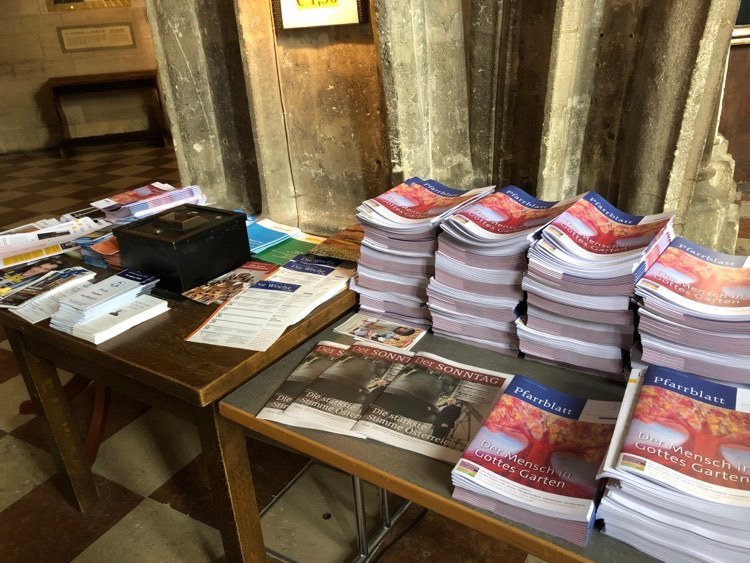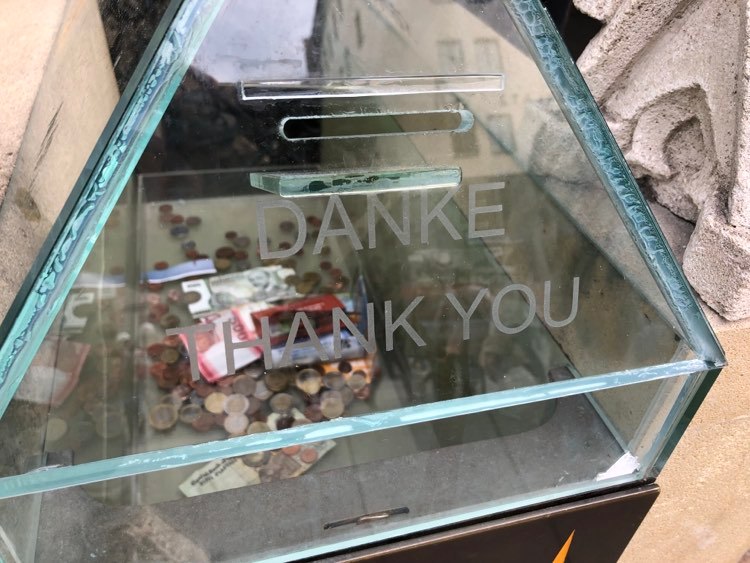
If you’re travelling to Vienna for the first time, you’re probably going to want to do and see all the things that tourists are supposed to do and see. You’ll want to see Schönbrunn palace, go to the opera house, visit the Hofburg. And if you like churches and cathedrals, you’ll definitely want to go to St Stephen’s in the heart of the inner city. It’s estimated that on average a staggering 14,000 people visit this historical building every day.[1] Among those visitors, a sizeable proportion naturally consists of people coming from abroad. The result is a large room full of people speaking a huge variety of different languages.
An attraction as famous and significant as St Stephen’s is bound to draw in people from all over the world, and it’s fair to assume that these people aren’t all necessarily going to be able to speak German. As with most tourist attractions, St Stephen’s shows visible attempts to acknowledge and cater for its multilingual audience. You can see this as soon as you approach the building:

This box houses a collection for the restoration and maintenance of the cathedral, and features an expression of gratitude in 38 different languages, including German (taking pride of place at the very top, in larger font and a different colour). This display just outside the cathedral is a symbolic welcome to people of all nations, and an acknowledgement of their individual languages. Of course, providing they speak one of the 38 languages included on the box. (If you want to know what your donation is actually going to be used for, you’ll have to speak German for that.)
This box is reminiscent of those posters you sometimes see in schools or public places such as libraries or health centres. You know the ones where “Hello!” is written in large writing in the middle, and orbiting the English word are “Hallo!”, “Bonjour!”, “Witam!”, and so on. Visitors to that doctor’s surgery are all welcomed with open arms, regardless of the languages they speak. At least, up to the point of reading the poster. Proceed any further and you’re likely to be stuck if you don’t speak the national official language. You might see the odd flyer in a different language, but a Turkish “Merhaba!” on a poster doesn’t automatically entitle you to have a consultation with the doctor in Turkish.
Lauren Gawne, co-host of the linguistics podcast Lingthusiasm, talks about a similar situation she encountered. She talks about
a community service centre that I used to access that had this wonderful wall when you walked in where it said, “Welcome,” in all of these different languages. We used to entertain ourselves by figuring out how many of them we knew. But once you accessed the service, you were really given the choice to only access the service in English. This very superficial, decorative multilingualism that existed on the wall but didn’t exist in any of the ways that you interacted with the service is a very different approach.[2]
Lingthusiam episode 67: What it means for a language to be official (first published 22nd April 2022)
It might be a little hasty of us to instantly brush off the thank yous on the collection box at St Stephen’s as “superficial, decorative multilingualism” in the same way as Lauren’s wall of welcomes. However, as we venture past the collection box and into St Stephen’s cathedral itself, we see the language situation start to change, just like in this imaginary doctor’s surgery or in this community service centre.
Off to the left as you enter the cathedral is the confessional booth, where you can see a sign displaying the languages in which confessional is offered. Alongside German, you can access this service in 24 languages, most of which being European and some being Asian. It’s encouraging to see this being available to people who speak different languages other than just German or English, even if the number of languages offered here is less than what is on display on the collection box.
As we make our way a little further into the cathedral, there is a sign located next to an information desk. This sign tells us when the main part of the cathedral is open or closed to the general public due to mass. The information is given in German and English at the top, followed by 18 other languages underneath. Not quite the 38 from outside but still a clear effort to address a multilingual audience.


Dotted around the cathedral you will find devices where you can pay to listen to information about St Stephen’s through a telephone, a so-called Phonomat. One Phonomat offers this information in 12 different languages – German, English, French, Italian, Dutch, Hungarian, Czech, Slovenian, Polish, Spanish, Russian and Japanese – still catering for people who don’t speak either German or English, but 12 languages is certainly a big step down from the 38 on the collection box. Another Phonomat will allow you to access the information in only 10 languages (Dutch and Polish didn’t make the cut).


If you want a slightly more immersive experience than listening to a recording on a telephone, you can attend a guided tour of the building. These tours are available in German and English only,[3] again a far cry from the 38 languages on that collection box. You could attend a mass, although these typically only take place in German, with the exception of a single weekly mass in English.[4] The more we look around and take in the languages on offer, the more this collection box display is starting to feel like “superficial, decorative multilingualism” after all.
There are a bunch of other signs and notices around the cathedral which make you wonder what St Stephen’s actual language policy is. The entrance sign is in German, English and Italian. There is a device accepting donations which you can access in German, English, Italian and Russian. There are multiple signs in just German and English. There is an advertisement that’s in English only – for a digital tour offered in three languages. There is historical information provided only in German, and all of the literature and flyers are only in German, too (as of the day I visited). If you don’t speak German, then it’s pot luck as to whether your language will be included on anything beyond the collection box.









Let’s go back to this collection box at the entrance of the cathedral, where the German Danke sits proudly at the top, and the remaining chosen 37 languages are dotted around the rest of the sign. If you spend a while studying it closely, you’re bound to realise something a little odd, namely the absence of English. This is strange since English is usually hyper-dominant when it comes to anything ‘international’ or ‘multilingual’. Here its absence is quite striking. One part of me thinks it is a bizarre choice to exclude English from such a sign, since the majority of tourists are very likely to speak English in some capacity and will at least recognise the phrase thank you. After all, English is famously the ‘world language’. Yet another part of me enjoys this omission of English. Why should English always enjoy being front and centre? Why should it be a given that English of all languages has a guaranteed spot in any multilingual display, and not Portuguese, Arabic or Malay? The fact that English for once has not made the shortlist is quite refreshing in a weird kind of way. Either that or this was an oversight on the part of the designers.
Hang on a moment…

Wait – there’s English! Right at the top where you put your money in… mystery solved! That brings our total number of languages to 39. This collection box is getting more and more inclusive the more we study it!
I don’t want to disparage the multilingual display on this collection box too much. Even if it ends up coming off as superficial in the light of the languages actually offered in the cathedral, it’s still a friendly and welcoming gesture, especially since its purpose is to express appreciation for voluntary donations. Still, it presents something of an exclusive club of 39 languages worthy of this appreciation. At least, it was 39 on my last count. Let’s look a little closer…

…oops! It looks like they’ve left in their “Lorem ipsum dolor” placeholder! I guess we’ll never know what the 39th language would have been to have the honour of making it onto this collection box…

Final thought: As if the language policy of St Stephen’s wasn’t confusing enough, they have to have a sign that literally mixes German and English!
Next post: Eltern haften für ihre Kinder..?
[1] https://www.classic-hotelwien.at/en/hotel-vienna-center-city-2-district-1020/news-blog-activities/st-stephens-cathedral-vienna/ (22.04.2022)
[2] https://lingthusiasm.com/post/682191718408388608/transcript-episode-67-what-it-means-for-a (22.04.2022)
[3] https://www.wien.info/en/sightseeing/sights/st-stephens-cathedral-359690 (22.04.2022)
[4] https://thebettervacation.com/st-stephens-cathedral-vienna/#mass-times (22.04.2022)

Pingback: Eltern haften für ihre Kinder..? - Yellow of the Egg
This design is incredible! You definitely know how to keep a reader
entertained. Between your wit and your videos, I was almost moved to start my own blog (well, almost…HaHa!) Wonderful job.
I really loved what you had to say, and more than that, how you presented it.
Too cool!
Thanks for your blog, nice to read. Do not stop.